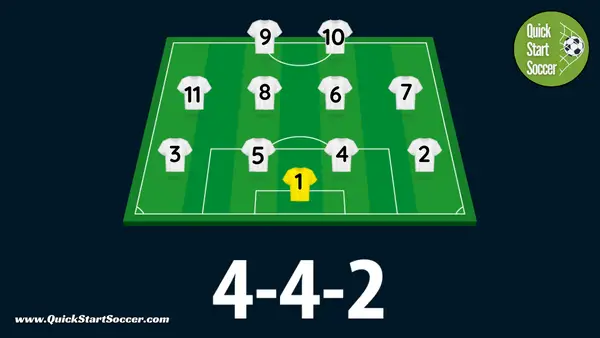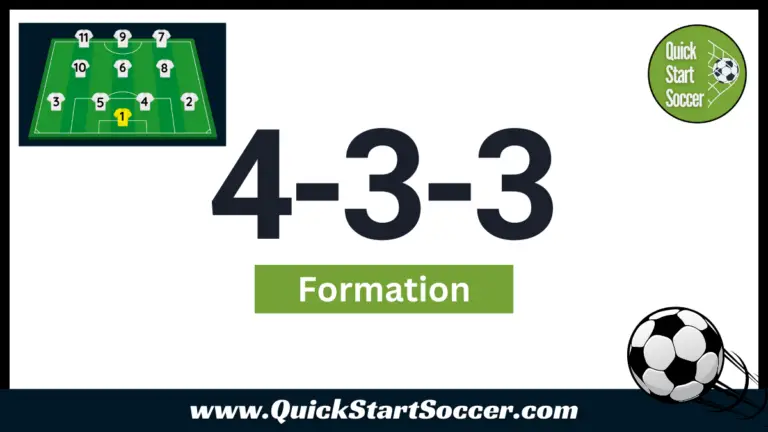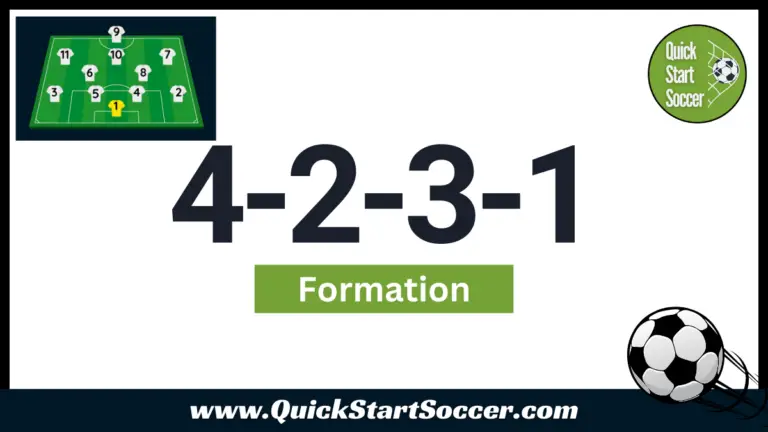4-4-2 Formation Explained | Tactics, Strengths, And Weaknesses
The 4-4-2 formation in soccer was once the go-to formation for teams across the globe. This was especially true in England when, at the dawn of the Premier League era, fast and furious counter-attacking football was the norm. At the time, it would be rare to see a game with at least one team not set up in a structure that could be solid and reliable in defense whilst simultaneously devastating and exciting in attack. With the emergence of the 4-3-3 formation in the early 21st century, the 4-4-2 formation lost its mantle as the most used and popular formation in modern soccer. However, the 4-4-2 still has many supporters among fans and the coaching community and can be seen today utilized by some of the world’s top professional teams.
Below you’ll find a detailed guide to the 4-4-2 soccer formation, along with its strengths and weaknesses. We’ll detail how to play the 4-4-2 formation, the difference between the 4-4-2 diamond formation and the traditional 4-4-2, and discuss the best formations to counter the 4-4-2 formation. First, let’s look at exactly what the 4-4-2 formation is.
What Is The 4-4-2 Formation In Soccer?

As the name suggests, the 4-4-2 formation consists of four defenders, four midfielders, and two attackers. These positions are arranged in three clearly defined lines or units. The defensive line consists of a right and left full-back and two center-backs. The midfield line has a right and left winger and two central midfielders. The forward unit has two central strikers/forwards.
4-4-2 Formation Strengths And Weaknesses
Strengths
The main strength of the 4-4-2 formation is its clearly defined roles. When defending, the four defenders and four midfielders are set up in two lines or units and can shift together from left to right, depending on where the ball is. This makes it easy to defend the entire width of the field. In addition to this, in both the midfield line and the defensive line, as one player pressures the ball, the remaining three players in the unit provide cover, balance, and support. When the 4-4-2 formation is used correctly, these two defensive units can make it very difficult for opponents to penetrate and create goalscoring opportunities.
The main strength of the 4-4-2 formation when attacking is that it offers natural width as well as plenty of options to make vertical passes and get up the field quickly. This makes it an ideal formation for quick counter-attacking soccer. For more aggressive teams, fullbacks also have the opportunity to join in attacks, combining with their wingers to create 2v1 situations in wide areas and get crosses into the box.
Another important strength of the 4-4-2 formation is that it has two central strikers, which makes it very difficult for teams that operate with just two central defenders. In this case, the central defenders have to mark ‘man to man’ and are constantly under the threat of being exposed in 1v1 situations.
Weaknesses
Like all formations, the 4-4-2 is not without its weaknesses. A significant weakness of the 4-4-2 formation is that it can be very physically demanding, especially for midfielders who have to get forward to support an attack and work back to help the defense.
Another weakness is that when playing against a 4-3-3 or 3-5-2 formation, there is a big risk of being outnumbered in the central midfield areas. This makes it hard to dominate possession and control the tempo of the game. Against well-organized teams, the rigid structure of the 4-4-2 can also make it more difficult for players to triangulate and create good passing options all over the field.
The 4-4-2 formation also has a problem if the four midfield players drop back too far, as this makes it difficult for the two strikers to press and win the ball against four defenders. This is particularly true when the opponents are adept at building out from the back.
The 4-4-2 Diamond Formation

A variation of the traditional 4-4-2 is the 4-4-2 diamond formation. It is designed to negate the weakness that a traditional 4-4-2 has by giving a team a greater number of players in the center of the field. A 4-4-2 diamond formation utilizes a deep-lying defensive midfielder (or a number 6), two traditional central midfielders (number 8’s), and an attacking central midfielder (number 10). The strength of a 4-4-2 diamond formation is that it enables teams to control the central midfield areas and possess the ball more effectively and consistently. The weakness is that by making this adjustment, you lose the natural width that the traditional 4-4-2 offers. The team no longer has traditional wingers, and as such, it can become more challenging to penetrate well-organized defenses and create goalscoring opportunities.
Best Formation To Counter 4-4-2
The best formation to counter the 4-4-2 is the 4-4-3. Known for its fluidity in and out of possession, the 4-3-3 formation can counter the 4-4-2 by quickly becoming a 4-5-1 formation in defense and switching to a 4-3-3 when attacking. With three central midfielders against two, possessing the ball in the middle park and controlling the game is more easily achievable. As with the 4-4-2, the 4-3-3 also allows the opportunity for fullbacks to join in attacks. For teams that would like to build out from the back, the 4-4-3 also offers triangulation and passing options all over the field, making it a great formation to counter a 4-4-2 playing team.
Clubs That Use The 4-4-2 Formation
Diego Simeone’s Athletico Madrid
Perhaps the highest profile team currently playing the 4-4-2, Diego Simeone’s Athletico Madrid has collected a large haul of trophies in a country traditionally dominated by European heavyweights Real Madrid and Barcelona. Athletico defends aggressively and remains compact at all times when out of possession. Upon stealing the ball they hit teams on the counter with devastating effect. It’s not always pretty to watch – unless you’re an Athletico fan!
Man Utd 1999 Treble-Winning Team
At a time when the 4-4-2 was the dominant formation, Alex Ferguson’s Manchester United was the dominant team. In 1999, the Red Devils won an unprecedented Treble of the English Premier League, FA Cup, and Uefa Championship League. Their strike partnership of Yorke and Cole tore defenses apart, with Beckham and Giggs providing speed and technique on the wings. Throw in the dominating central midfield partnership of Keane and Scholes, and you had the makeup of what was arguably the most effective and exciting 4-4-2 team of all time!
More Formation Guides
One of the things that makes soccer such a fascinating sport to watch, coach, and play, is the variety of tactics and formations that can be utilized to maximize a team’s chances of winning on the day. Before you go, be sure to check out some of our other formation guides below to see the strengths and weaknesses of each of these formations and how teams are using these to up their game.







